Search results for: 'test nat'
- Related search terms
- Nat
- Natural gas
- Natural gas e
- Natural gas g
- Natural gas ge
-
 TT-2778 NATIONAL 110 UE 1500 HP SCR OIL RIG, YEAR 2006TT-2778 NATIONAL 110 UE 1500 HP SCR OIL RIG, YEAR 2006 NATIONAL 110 UE 1500 HP SCR MAJOR REBUILD LIKE NEW (RIG BUILT NEW IN 2006) Learn More
TT-2778 NATIONAL 110 UE 1500 HP SCR OIL RIG, YEAR 2006TT-2778 NATIONAL 110 UE 1500 HP SCR OIL RIG, YEAR 2006 NATIONAL 110 UE 1500 HP SCR MAJOR REBUILD LIKE NEW (RIG BUILT NEW IN 2006) Learn More -
 TT-5642 NATURAL GAS TREATMENT PLANT, CAPACITY 10,880,000 M3 PER DAYTT-5642 NATURAL GAS TREATMENT PLANT, CAPACITY 10,880,000 M3 PER DAY NATURAL GAS TREATMENT PLANT CAPACITY 10,880,000 M3 PER DAY (384,223,000 CFD) USED QUANTITY: 1 Learn More
TT-5642 NATURAL GAS TREATMENT PLANT, CAPACITY 10,880,000 M3 PER DAYTT-5642 NATURAL GAS TREATMENT PLANT, CAPACITY 10,880,000 M3 PER DAY NATURAL GAS TREATMENT PLANT CAPACITY 10,880,000 M3 PER DAY (384,223,000 CFD) USED QUANTITY: 1 Learn More -
 TT-3855 CUMMINS NATURAL GAS GENERATOR SET, 1.4MW, 1400 KW, NATURAL GAS, YEAR 2017, 50Hz/60HzTT-3855 CUMMINS NATURAL GAS GENERATOR SET, 1.4MW, 1400 KW, NATURAL GAS, YEAR 2017, 50Hz/60Hz SERIES ENGINE MODEL C1400 N6C. USED YEAR 2017 SYSTEM INCLUDES BUILDING, COOLING SYSTEM, TRANSFORMER. TOTAL HOURS: 5400 1400 KW USED AS BACK UP GENERATOR WEIGHT: 28,300 LBS. Learn More
TT-3855 CUMMINS NATURAL GAS GENERATOR SET, 1.4MW, 1400 KW, NATURAL GAS, YEAR 2017, 50Hz/60HzTT-3855 CUMMINS NATURAL GAS GENERATOR SET, 1.4MW, 1400 KW, NATURAL GAS, YEAR 2017, 50Hz/60Hz SERIES ENGINE MODEL C1400 N6C. USED YEAR 2017 SYSTEM INCLUDES BUILDING, COOLING SYSTEM, TRANSFORMER. TOTAL HOURS: 5400 1400 KW USED AS BACK UP GENERATOR WEIGHT: 28,300 LBS. Learn More -
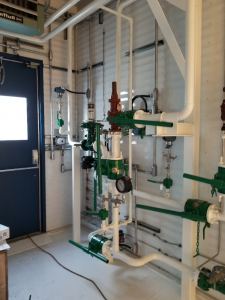 TT-4046 GENERAL ELECTRIC 7E.03 NATURAL GAS GENERATOR PACKAGE, 86.5 MW, YEAR 2014TT-4046 GENERAL ELECTRIC 7E.03 NATURAL GAS GENERATOR PACKAGE, 86.5 MW, YEAR 2014 GENERAL ELECTRIC 7E.03 NATURAL GAS GENERATOR PACKAGE YEAR: 2014 HOUSED: YES, IN A AMBIENT CONTROLLED WAREHOUSE IN TWO LOCATIONS WHAT DOESN’T HAVE TO BE INDOORS, IS OUTSIDE ON AN ENCLOSED FIELD, 2.5 HOURS AWAY FROM THE WAREHOUSES. SKIDDED: NO PASC CONDITION RATING: A CONDITION DETAILS: NEVER USED UNITS AVAILABLE: 1 CONNECTION STATUS: DISCONNECTED WARRANTY: NO WARRANTY DETAILS: EXP DEC 2018 Learn More
TT-4046 GENERAL ELECTRIC 7E.03 NATURAL GAS GENERATOR PACKAGE, 86.5 MW, YEAR 2014TT-4046 GENERAL ELECTRIC 7E.03 NATURAL GAS GENERATOR PACKAGE, 86.5 MW, YEAR 2014 GENERAL ELECTRIC 7E.03 NATURAL GAS GENERATOR PACKAGE YEAR: 2014 HOUSED: YES, IN A AMBIENT CONTROLLED WAREHOUSE IN TWO LOCATIONS WHAT DOESN’T HAVE TO BE INDOORS, IS OUTSIDE ON AN ENCLOSED FIELD, 2.5 HOURS AWAY FROM THE WAREHOUSES. SKIDDED: NO PASC CONDITION RATING: A CONDITION DETAILS: NEVER USED UNITS AVAILABLE: 1 CONNECTION STATUS: DISCONNECTED WARRANTY: NO WARRANTY DETAILS: EXP DEC 2018 Learn More -
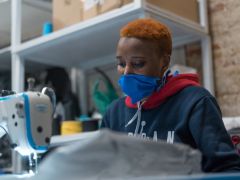 D-2388 What’s the Best Material for a Mask?
D-2388 What’s the Best Material for a Mask?Federal health officials have now recommended that we cover our faces with fabric during the coronavirus pandemic. But what material offers the most protection?
The Centers for Disease Control and Prevention has posted a no-sew mask pattern using a bandanna and a coffee filter as well as a video on making masks using rubber bands and folded fabrics found at home.
While a simple face covering can reduce the spread of coronavirus by blocking outgoing germs from coughs or sneezes of an infected person, experts say there is more variation in how much homemade masks might protect the wearer from incoming germs, depending on the fit and quality of the material used.
Scientists around the country have taken it upon themselves to identify everyday materials that do a better job of filtering microscopic particles. In recent tests, HEPA furnace filters scored well, as did vacuum cleaner bags, layers of 600-count pillowcases and fabric similar to flannel pajamas. Stacked coffee filters had medium scores. Scarves and bandanna material had the lowest scores, but still captured a small percentage of particles.
If you don’t have any of the materials that were tested, a simple light test can help you decide whether a fabric is a good candidate for a mask.
“Hold it up to a bright light,” said Dr. Scott Segal, chairman of anesthesiology at Wake Forest Baptist Health who recently studied homemade masks. “If light passes really easily through the fibers and you can almost see the fibers, it’s not a good fabric. If it’s a denser weave of thicker material and light doesn’t pass through it as much, that’s the material you want to use.”
Researchers say it’s important to remember that lab studies are conducted under perfect conditions with no leaks or gaps in the mask, but the test methods give us a way to compare materials. And while the degree of filtration for some homemade masks seems low, most of us — who are staying home and practicing social distancing in public — don’t need the high level of protection required for medical workers. More important, any face covering is better than none, especially if worn by a person who has the virus but doesn’t know it.
The biggest challenge of choosing a homemade mask material is to find a fabric that is dense enough to capture viral particles, but breathable enough that we can actually wear it. Some items being touted online promise high filtration scores, but the material would be unwearable.
Dressing Up for Work … at Home
Yang Wang, an assistant professor of environmental engineering at Missouri University of Science and Technology, worked with his graduate students to study various combinations of layered materials — including both air filters and fabric. “You need something that is efficient for removing particles, but you also need to breathe,” said Dr. Wang, who last fall won an international award for aerosol research.To test everyday materials, scientists are using methods similar to those used to test medical masks, which everybody agrees should be saved for medical workers who are exposed to high doses of virus from seeing infected patients. The best medical mask — called the N95 respirator — filters out at least 95 percent of particles as small as 0.3 microns. By comparison, a typical surgical mask — made using a rectangular piece of pleated fabric with elastic ear loops — has a filtration efficiency ranging from 60 to 80 percent.
Dr. Wang’s group tested two types of air filters. An allergy-reduction HVAC filter worked the best, capturing 89 percent of particles with one layer and 94 percent with two layers. A furnace filter captured 75 percent with two layers, but required six layers to achieve 95 percent. To find a filter similar to those tested, look for a minimum efficiency reporting value (MERV) rating of 12 or higher or a microparticle performance rating of 1900 or higher.
The problem with air filters is that they potentially could shed small fibers that would be risky to inhale. So if you want to use a filter, you need to sandwich the filter between two layers of cotton fabric. Dr. Wang said one of his grad students made his own mask by following the instructions in the C.D.C. video, but adding several layers of filter material inside a bandanna.
Dr. Wang’s group also found that when certain common fabrics were used, two layers offered far less protection than four layers. A 600 thread count pillow case captured just 22 percent of particles when doubled, but four layers captured nearly 60 percent. A thick woolen yarn scarf filtered 21 percent of particles in two layers, and 48.8 percent in four layers. A 100 percent cotton bandanna did the worst, capturing only 18.2 percent when doubled, and just 19.5 percent in four layers.
The group also tested Brew Rite and Natural Brew basket-style coffee filters, which, when stacked in three layers, showed 40 to 50 percent filtration efficiency — but they were less breathable than other options.
If you are lucky enough to know a quilter, ask them to make you a mask. Tests performed at the Wake Forest Institute for Regenerative Medicine in Winston-Salem, N.C., showed good results for homemade masks using quilting fabric. Dr. Segal, of Wake Forest Baptist Health, who led the study, noted that quilters tend to use high-quality, high-thread count cotton. The best homemade masks in his study were as good as surgical masks or slightly better, testing in the range of 70 to 79 percent filtration. Homemade masks that used flimsier fabric tested as low as 1 percent filtration, Dr. Segal said.
The best-performing designs were a mask constructed of two layers of high-quality, heavyweight “quilter’s cotton,” a two-layer mask made with thick batik fabric, and a double-layer mask with an inner layer of flannel and outer layer of cotton.
Bonnie Browning, executive show director for the American Quilter’s Society, said that quilters prefer tightly woven cottons and batik fabrics that stand up over time. Ms. Browning said most sewing machines can handle only two layers of fabric when making a pleated mask, but someone who wanted four layers of protection could wear two masks at a time.
Ms. Browning said she recently reached out to quilters on Facebook and heard from 71 people who have made a combined total of nearly 15,000 masks. “We quilters are very much in the thick of what’s going on with this,” said Ms. Browning, who lives in Paducah, Ky. “One thing most of us have is a stash of fabric.”
People who don’t sew could try a folded origami mask, created by Jiangmei Wu, assistant professor of interior design at Indiana University. Ms. Wu, who is known for her breathtaking folded artwork, said she began designing a folded mask out of a medical and building material called Tyvek, as well as vacuum bags, after her brother in Hong Kong, where mask wearing is common, suggested it. (DuPont, the maker of Tyvek, said in a statement that Tyvek is intended for medical apparel, not masks.) The folded mask pattern is free online, as is a video demonstrating the folding process. In tests at Missouri University and University of Virginia, scientists found that vacuum bags removed between 60 percent and 87 percent of particles. But some brands of vacuum bags may contain fiberglass or are harder to breathe through than other materials, and shouldn’t be used. Ms. Wu used a bag by EnviroCare Technologies, which has said it does not use fiberglass in its paper and synthetic cloth bags.
“I wanted to create an alternative for people who don’t sew,” said Ms. Wu, who said she is talking to various groups to find other materials that will be effective in a folded mask. “Given the shortage of all kinds of materials, even vacuum bags might run out.”
The scientists who conducted the tests used a standard of 0.3 microns because that is the measure used by the National Institute for Occupational Safety and Health for medical masks.
Linsey Marr, a Virginia Tech aerosol scientist and an expert in the transmission of viruses, said the certification method for respirators and HEPA filters focuses on 0.3 microns because particles around that size are the hardest to catch. While it seems counterintuitive, particles smaller than 0.1 microns are actually easier to catch because they have a lot of random motion that makes them bump into the filter fibers, she said.
“Even though coronavirus is around 0.1 microns, it floats around in a wide range of sizes, from around 0.2 to several hundred microns, because people shed the virus in respiratory fluid droplets that also contain lots of salts and proteins and other things,” said Dr. Marr. “Even if the water in the droplets fully evaporates, there’s still a lot of salt and proteins and other gunk that stays behind as solid or gel-like material. I think 0.3 microns is still useful for guidance because the minimum filtration efficiency will be somewhere around this size, and it’s what NIOSH uses.”
Learn More -
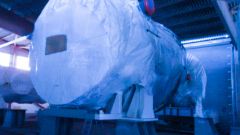 TT-8656 SIEMENS SGT5 4000 F GAS TURBINE & GENERATOR – NEW, 54 MW, YEAR 2016, 50/60 HzTT-8656 SIEMENS SGT5 4000 F GAS TURBINE & GENERATOR – NEW, 54 MW, YEAR 2016, 50/60 Hz 1. NEW AND UNUSED SIEMENS GAS TURBINE & GENERATOR 2. HEAVY DUTY, SINGLE CASING, AXIAL FLOW DESIGN AND DUAL FUEL GAS TURBINE. 3. MODEL: SGT54000F 4. BRAND: SIEMENS AG 5. 54 MW 6. YEAR OF MANUFACTURE: 2016 7. FREQUENCY: 50 Hz 8. FUEL: NATURAL GAS (NG) AND DIESEL OIL (DO) 9. GUARANTEED PERFORMANCE: 10. GROSS POWER OUTPUT [MW]: 298,2 (NG) – 301 (DO). 11. GROSS HEAT RATE [KJ/KWH]: 8979,3 (NG) – 9538,5 (DO). 12. GENERATOR: SGEN51200 A. 13. INCLUDES: BYPASS STACK AND DIVERTER DAMPER. 14. DELIVERY: IMMEDIATELY. BUYER IS RESPONSIBLE FOR LOADING, FREIGHT AND LOGISTICS FROM ACTUAL LOCATION TO FINAL DESTINATION. 15. DETAILED DESCRIPTION: GAS TURBINE (GT) 16. IT WORKS ON 50 Hz BUT COULD BE CONVERTED, WITH ADDITIONAL EQUIPMENT FOR 60 Hz (EXTRA COSTS). QUANTITY: 1 Learn More
TT-8656 SIEMENS SGT5 4000 F GAS TURBINE & GENERATOR – NEW, 54 MW, YEAR 2016, 50/60 HzTT-8656 SIEMENS SGT5 4000 F GAS TURBINE & GENERATOR – NEW, 54 MW, YEAR 2016, 50/60 Hz 1. NEW AND UNUSED SIEMENS GAS TURBINE & GENERATOR 2. HEAVY DUTY, SINGLE CASING, AXIAL FLOW DESIGN AND DUAL FUEL GAS TURBINE. 3. MODEL: SGT54000F 4. BRAND: SIEMENS AG 5. 54 MW 6. YEAR OF MANUFACTURE: 2016 7. FREQUENCY: 50 Hz 8. FUEL: NATURAL GAS (NG) AND DIESEL OIL (DO) 9. GUARANTEED PERFORMANCE: 10. GROSS POWER OUTPUT [MW]: 298,2 (NG) – 301 (DO). 11. GROSS HEAT RATE [KJ/KWH]: 8979,3 (NG) – 9538,5 (DO). 12. GENERATOR: SGEN51200 A. 13. INCLUDES: BYPASS STACK AND DIVERTER DAMPER. 14. DELIVERY: IMMEDIATELY. BUYER IS RESPONSIBLE FOR LOADING, FREIGHT AND LOGISTICS FROM ACTUAL LOCATION TO FINAL DESTINATION. 15. DETAILED DESCRIPTION: GAS TURBINE (GT) 16. IT WORKS ON 50 Hz BUT COULD BE CONVERTED, WITH ADDITIONAL EQUIPMENT FOR 60 Hz (EXTRA COSTS). QUANTITY: 1 Learn More -
 TT-8216 WAUKESHA L7042 GSI, 1104KW, NATURAL GAS, YEAR 2024, 50/60 HzTT-8216 WAUKESHA L7042 GSI, 1104KW, NATURAL GAS, YEAR 2024, 50/60 Hz 1. BRAND: WAUKESHA 2. MODEL: L7042 GSI 3. YEAR: 2024 4. HOURS: 0 QUANTITY: 1 Learn More
TT-8216 WAUKESHA L7042 GSI, 1104KW, NATURAL GAS, YEAR 2024, 50/60 HzTT-8216 WAUKESHA L7042 GSI, 1104KW, NATURAL GAS, YEAR 2024, 50/60 Hz 1. BRAND: WAUKESHA 2. MODEL: L7042 GSI 3. YEAR: 2024 4. HOURS: 0 QUANTITY: 1 Learn More -
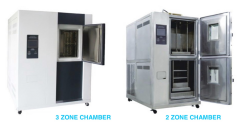 YY-2186 THERMAL SHOCK TEST CHAMBER, TEST METHOD 2 ZONE TYPE OR 3 ZONE TYPEYY-2186 THERMAL SHOCK TEST CHAMBER, TEST METHOD 2 ZONE TYPE OR 3 ZONE TYPE DETAILS: THE THERMAL SHOCK TEST CHAMBER IS WELL ESTABLISHED TESTING MACHINE OF ELECTRONIC COMPONENTS, METAL, CHEMICAL MATERIALS, AUTOMATION COMPONENTS, COMMUNICATION MODULE, NATIONAL DEFENSE INDUSTRY, AEROSPACE INDUSTRY, PCB SUBSTRATE, ELECTRONIC CHIP INTEGRATED CIRCUITS, SEMICONDUCTOR CERAMIC AND HIGH POLYMER MATERIALS. MEET THE FOLLOWING STANDARDS: GB/T2423.1-1989, GB/T2423.2-1989, GB/R2423.22-1989, GJB150.5-86, GJB360.7-87, GJB367.2-87 405, SJ/T10187-91Y73, SJ/T10186-91Y73, IEC68-2-14, GB/T2424.13-2002, GB/T 2423.22-2002, QC/T17-92, EIA 364-32. QUANTITY: 1 Learn More
YY-2186 THERMAL SHOCK TEST CHAMBER, TEST METHOD 2 ZONE TYPE OR 3 ZONE TYPEYY-2186 THERMAL SHOCK TEST CHAMBER, TEST METHOD 2 ZONE TYPE OR 3 ZONE TYPE DETAILS: THE THERMAL SHOCK TEST CHAMBER IS WELL ESTABLISHED TESTING MACHINE OF ELECTRONIC COMPONENTS, METAL, CHEMICAL MATERIALS, AUTOMATION COMPONENTS, COMMUNICATION MODULE, NATIONAL DEFENSE INDUSTRY, AEROSPACE INDUSTRY, PCB SUBSTRATE, ELECTRONIC CHIP INTEGRATED CIRCUITS, SEMICONDUCTOR CERAMIC AND HIGH POLYMER MATERIALS. MEET THE FOLLOWING STANDARDS: GB/T2423.1-1989, GB/T2423.2-1989, GB/R2423.22-1989, GJB150.5-86, GJB360.7-87, GJB367.2-87 405, SJ/T10187-91Y73, SJ/T10186-91Y73, IEC68-2-14, GB/T2424.13-2002, GB/T 2423.22-2002, QC/T17-92, EIA 364-32. QUANTITY: 1 Learn More -
 T-6543 MEDICAL UNIVERSAL TENSILE TESTING EQUIPMENT
T-6543 MEDICAL UNIVERSAL TENSILE TESTING EQUIPMENTREFERENCE NUMBER: T-6543
MEDICAL UNIVERSAL TENSILE TESTING EQUIPMENT
SHANDONG INDEPENDENTLY RESEARCH AND DEVELOPMENT THIS COMPREHENSIVE TESTING MACHINE FOR SURGICAL MASK & PROTECTIVE CLOTHING, IT IS WIDELY USED IN A VARIETY OF MASK STRENGTH DETECTION PROJECTS.FEATURES:COMPLY WITH NATIONAL STANDARDS, MEDICAL STANDARDS TESTING REQUIREMENTS, AUTOMATIC SOFTWARE CONTROL SYSTEM, MEET THE REQUIREMENTS OF DATA STORAGE, PRINTING, COMPARISON. THE IMPORTED SERVO MOTOR IS EQUIPPED WITH PRECISION SCREW DRIVE SYSTEM TO ENSURE THE STABILITY OF TEST DATA.
TEST STANDARDS:
GB 19082-2009 TECHNICAL REQUIREMENTS FOR DISPOSABLE PROTECTIVE CLOTHING FOR MEDICAL USE (4.5 BREAKING STRENGTH -THE BREAKING STRENGTH OF MATERIALS IN KEY PARTS OF PROTECTIVE CLOTHING SHOULD NOT BE LESS THAN 45N)
(4.6 ELONGATION AT BREAK -THE ELONGATION AT BREAK OF KEY PARTS OF PROTECTIVE CLOTHING SHOULD NOT BE LESS THAN 15%)
SELF-PRIMING FILTER RESPIRATOR FOR RESPIRATORY PROTECTION ARTICLES5.6.2 BREATHING BONNET -BREATHING BONNET SHALL BE SUBJECT TO AXIAL TENSION"DISPOSABLE MASK: 10N FOR 10S" "REPLACEABLE MASK: 50N FOR 10S"
(5.9 HEADBAND -HEADBAND SHOULD BEAR THE TENSION "DISPOSABLE MASK: 10N, 10S" "REPLACEABLE HALF MASK: 50N FOR 10S" "FULL MASK: 150N FOR 10S")
5.10 JOINTS AND CONNECTING PARTS -JOINTS AND CONNECTING PARTS SHALL BE SUBJECT TO AXIAL TENSION
"REPLACEABLE HALF MASK: 50N FOR 10S" "FULL COVER 250N FOR 10S"
GB/T 32610-2016 TECHNICAL SPECIFICATION FOR DAILY PROTECTIVE MASKS
(6.9 BREAKING STRENGTH OF THE MASK BELT AND THE CONNECTION BETWEEN THE MASK BELT ANDTHE MASK BODY ≥ 20N)
(6.10 FASTNESS TO BREATHING BONNET: NO SLIPPAGE, BREAKAGE OR DEFORMATION SHALL OCCUR)
YY/T 0699-2013 DISPOSABLE SURGICAL MASK
(4.4 MASK BELT -THE BREAKING FORCE AT THE CONNECTION POINT BETWEEN EACH MASK BELT AND THE MASK BODY IS NOT LESS THAN 10N)
YY 0469-2011 SURGICAL MASK FOR MEDICAL USE (5.4.2 MASK BELT)
GB/T 3923.1-1997 DETERMINATION OF BREAKING STRENGTH AND ELONGATION AT BREAK OF FABRICS (STRIP METHOD)
DISPOSABLE RUBBER INSPECTION GLOVES (6.3 TENSILE PROPERTIES)
INSTRUMENT TECHNICAL PARAMETERS:
SPECIFICATION: 200N (STANDARD) 50N, 100N, 500N, 1000N (OPTIONAL)
ACCURACY: BETTER THAN 0.5RESOLUTION OF FORCE VALUE: 0.1N
DEFORMATION RESOLUTION: 0.001mm
TEST SPEED: 0.01mm/MIN ~ 2000mm/MIN (STEPLESS SPEED REGULATION)
WIDTH OF SAMPLE: 30mm (STANDARD FIXTURE) 50mm (OPTIONAL FIXTURE)
CLAMPING OF SAMPLES: MANUAL (PNEUMATIC CLAMPING CAN BE CHANGED)
STROKE: 700mm (STANDARD) 400mm, 1000mm (OPTIONAL)
QUANTITY: 1
Learn More -
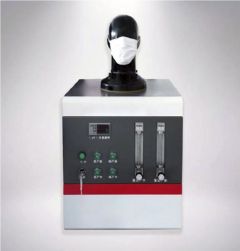 T-6547 RESPIRATOR RESISTANCE TESTER FOR FACE MASKS
T-6547 RESPIRATOR RESISTANCE TESTER FOR FACE MASKSREFERENCE NUMBER: T-6547
RESPIRATOR RESISTANCE TESTER FOR FACE MASKS
INTRODUCTION
THE RESPIRATOR RESISTANCE TESTER IS USED TO MEASURE THE INSPIRATORY RESISTANCE AND EXPIRATORY RESISTANCE OF RESPIRATORS AND RESPIRATOR PROTECTORS UNDER SPECIFIED CONDITIONS. IT IS APPLICABLE TO THE NATIONAL LABOR PROTECTION EQUIPMENT INSPECTION INSTITUTIONS, MASK MANUFACTURERS FOR THE GENERAL MASKS, DUST MASKS, MEDICAL MASKS, ANTI-SMOG MASKS PRODUCTS OF THE RELEVANT TESTING AND INSPECTION.
STANDARD
GB 19083-2010 TECHNICAL REQUIREMENTS FOR MEDICAL PROTECTIVE MASKS
GB 2626-2006 RESPIRATOR SELF-SUCTION FILTER RESPIRATOR AGAINST PARTICULATE MATTER
GB/T 32610-2016 TECHNICAL SPECIFICATIONS FOR DAILY PROTECTIVE MASKS
FEATURES:
1. HIGH-DEFINITION LCD DISPLAY.
2. DIGITAL DIFFERENTIAL PRESSURE METER WITH HIGH PRECISION IMPORTED BRAND.
3. HIGH PRECISION IMPORTED BRAND OF DIGITAL FLOWMETER, WITH HIGH FLOW CONTROL ACCURACY FEATURES.
4. THE RESPIRATOR RESISTANCE TESTER CAN SET UP TWO MODES: EXHALATION DETECTION AND INHALATION DETECTION.
5. AUTOMATIC PIPELINE SWITCHING DEVICE OF RESPIRATOR SOLVES THE PROBLEM OF PIPE EXTUBATION AND WRONG CONNECTION WHEN TESTING.
PARAMETER:
1. FLOWMETER RANGE: 0 ~ 100L/MIN, ACCURACY IS 3%
2. DIGITAL PRESSURE DIFFERENCE METER RANGE: 0 ~ 2000PA, ACCURACY: 1PA
3. PUMPING CAPACITY OF AIR PUMP: >100L/MIN
4. OVERALL SIZE: 460 X 1080 X 670mm
5. POWER SOURCE: AC220V 50HZ 650W
6. WEIGHT: 55KG
QUANTITY: 1
Learn More
